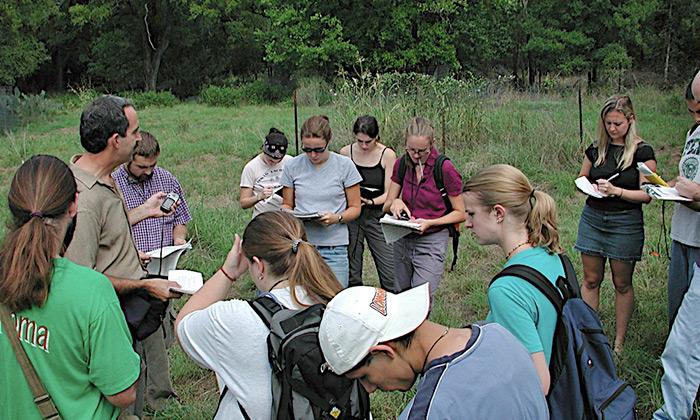Jacob Heiling (BS '13) was already interested in biology when he started working as a greenhouse assistant at the Brackenridge Field Laboratory (BFL) as an undergraduate. The time he spent watching butterflies interact in the greenhouse sparked his interest in studying species interactions, and that led to an independent research project on the chemical ecology of bird-dispersed fruits.
"I think part of why I was able to do that was the freedom to explore that you get at a place like Brackenridge Field Lab, which you wouldn't really have if you were just sitting in a library or sitting in a lab thinking about ecology," says Heiling, who is now a graduate student at Dartmouth University.

Thousands of biology students and alums know the BFL, a mere three miles from the main campus of The University of Texas at Austin, as a great place to get out of the classroom and get real, boots-on-the-ground experience in science. The lab’s national reputation—as a premiere site for research on invasive species, evolution and behavior, biodiversity, climate change and drought, as well as for education and outreach—was recently underscored with the lab’s inclusion in a report by the National Academy of Sciences on the critical role of field stations. The teaching component sets BFL apart from other Organized Research Units at the university.
In a time of global climate change, emerging technology and growing awareness about the importance of hands-on, discovery-based learning, the report argues field labs are more important than ever.
The report notes that field labs advance science research by:
- Enabling collection of long-term environmental data needed to understand current changes in ecosystems and climate; and
- Fostering collaborations and interdisciplinary research that sparks innovation and discovery.
One example cited in the report was work at BFL by scientists and students that led to a potential pest reduction for an invasive species. Students and other researchers demonstrated that parasitic flies that harass one species of red fire ant make that species less competitive with other ant species and thereby reduce their access to food. That insight led to an innovative way to control invasive fire ants: introduce parasitic phorid flies from South America.
Now the host-specific flies are established across millions of acres of Texas as a self-sustaining contribution to efforts to control fire ant populations. It's a welcome weapon in the war on a pest that's estimated to cost Texas alone more than $1.2 billion annually. The authors of the NAS report highlighted this work as an example of the powerful and unpredictable impact of basic research in a long-term field setting. Research that began at BFL and its satellite site, the Stengl Lost Pines Biological Station, have led to advances in land management, other invasive species control and even medical technology.
Larry Gilbert, director of the Brackenridge Field Laboratory, says BFL also promotes effective science education, in ways the NAS report describes as critical. By enabling hands-on, discovery-based learning and promoting the STEM fields, as educational and career options to diverse students, field stations let students pose their own questions, develop hypotheses and design experiments to address their questions. At BFL the major breakthrough about fire ants began with an undergraduate student research project.
"That student’s research led to just about everything that happened later, quite a few millions in grant money and lots of progress in the science of biological control," says Gilbert. "An undergraduate research project led to faculty research, though we often think of it the other way around."
Rob Plowes, co-coordinator of the lab's Invasive Species Research Program and coordinator of research and education for BFL and SLP, says much of the research done at BFL is based on data collected by students.
"The data from their research projects form a baseline going back decades that others can use for meta-analyses," he says. "You can look at data collected 20 years ago, for example, and go make the same observations now and compare the differences."
The NAS report suggested three ways that leaders of field stations like BFL and SLP could leverage their unique place in the worlds of research, education and outreach for even greater impact:
- Join networks to share data that would allow scientists to study changes on regional to global scales, such as droughts, climate change and extreme weather events;
- Make "dark data"—data that are not currently stored in digitally accessible formats—available to the scientific community; and
- Foster the convergence of multiple disciplines by bringing together not just biologists, but also physical scientists, engineers, artists and historians.
Gilbert and Plowes are interested in pursuing all three recommendations to help scientists take the long view.
Collecting data to answer a specific question today will be only part of the work of field stations, they note, because when new scientific questions arise, sometimes decades later, that same data combined with the ability to go back to the same place for comparative study makes the field station increasingly useful over time.

















Comments